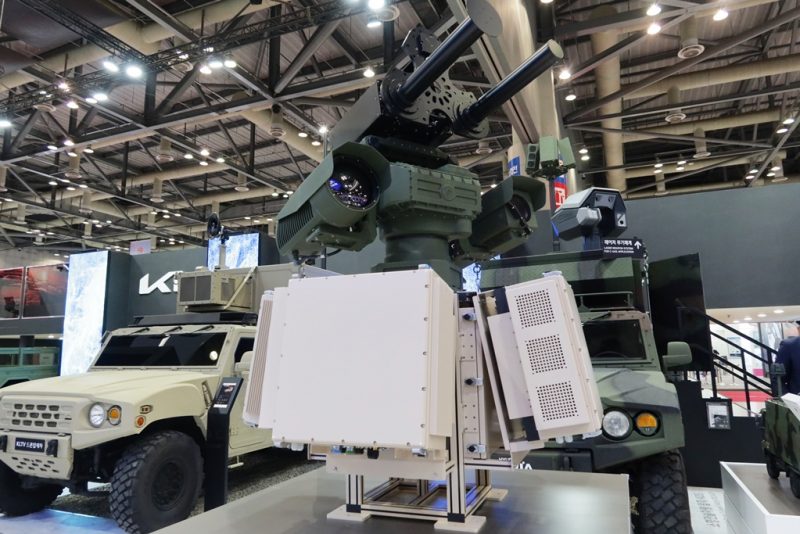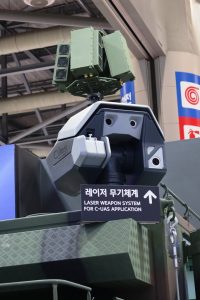ADEX 2025 – Hyundai WIA unveils its all-in-one ADS Anti Drone System
The increasing threat posed by drones is bringing numerous companies to develop solutions to counter incoming UAVs of various types. Hyundai WIA is no exception, and at the Seoul exhibition it showcased its Anti Drone Solution, ADS in short, a vehicle-based multi-layer system
Protecting military units in operation against the drone threat needs to deploy mobile solutions, capable to follow units’ movement, providing an overhead protection bubble. This is what Hyundai KIA proposes with its ADS, a system that includes sensors as well as soft- and hard-kill effectors and can be installed for example on a KIA K153 light tactical vehicle.
The system is hosted in a shelter which main sensors are the AESA radar, installed on a telescopic mast, the four flat antennas ensuring full 360° coverage. At the exhibition, the radar complex was shown on a mount, not installed on the vehicle. EDR On-Line understood that its performances can be customised according to customer’s need, detection range being between 10 and 15 km.
The second sensor is the optronic suite, which is mounted on a pan and tilt head, the daylight channel being fitted with a 66x optical zoom while the night channel, based on a thermal camera, has a 22x optical zoom. According to company data the identification range is 3 km.
On top of the optronic head was installed the jammer, the soft-kill effector, with its typical antennas aimed at emitting radiofrequency signals capable to disturb GNSS navigation at distances up to 20 km, as well as data-link signals. Should the jammer not succeed in diverting the incoming UAV, the second layer of protection is provided by the remotely controlled weapon station.
Hyundai WIA improved its RCWS increasing accuracy thanks to improvement in the 2-axis stabilisation system. Stabilisation accuracy is now less than 0.8 mrad RMS, aiming accuracy being less than 2.4 mrad RMS. New artificial intelligence-based algorithms have also increased the efficiency automatic target identification; images acquired are processed through a high-speed graphic processor unit, real time object recognition, identification and classification being ensured by AI-algorithms. The system improves its performances along time thanks to supervised learning. The RCWS optronic suite exploits image fusion technology and ensures a 4 km detection range and a 2 km identification range, the system operator providing positive identification before opening fire. When part of the ADS the longer range optronics will take over this function. The RCWS can be armed with a 7.62 mm machine gun, or a 12.7 mm heavy machine gun with a maximum of 200 rounds, but the most effective weapon against drone is the automatic grenade launcher firing high-speed 40 mm airburst grenades, capable of generating a cloud of fragments in front of the incoming drone, the AGL having a 48 rounds ammunition capacity, the rate of fire of the grenade launcher allowing also to counter swarm attacks.
All functions are centralised into a command-and-control console, AI helping in reducing operators’ workload and reducing the sensor-to-shooter time, two personnel operating the two C2 consoles hosted in the shelter installed on the flatbed of the vehicle. A stationary ADS version hosted in a 20-foot shelter is also available.
Some optional items are offered by Hyundai WIA to complement the aforementioned sensors and effectors. Among them an acoustic gunshot detector, the Drone Hunter killer drone, and a laser weapon system. At the Seoul exhibition the system was fitted with CILAS Helma-P effector, a laser system capable to damage optics at 3,000 metres distance and neutralise a drone at a maximum distance of 1,000 metres, neutralisation range depending on weather conditions and on the type of drone, no details about the laser emitter power being provided.
Photos by P. Valpolini





